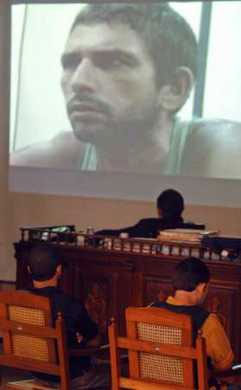Dangerous times on Brazil’s Amazon frontier
Andrew Hay
Reuters
December 22, 2005
ALTAMIRA, Brazil, Dec 22 (Reuters) – Amazon land activist Deurival Santiago has the look of a hunted man.
Unshaven, his eyes bloodshot and his head bowed, the 53-year-old sits in the back room of a safe house near Brazil’s muddy Trans-Amazonian highway as logging trucks roll by outside.
A friend watches the gate for gunmen he says were hired to kill him after he clashed with land grabbers advancing on the prized eastern flank of Brazil’s Amazon rain forest.
 Raifran das Neves Sales (R) and Clodoaldo Carlos Batista look at a video during trial at the Justice Tribunal in the Brazilian city of Belem, capital of Para state, December 9, 2005. Sales and Batista are expected to plead guilty on Friday to killing 73-year-old American nun, Dorothy Stang, who defended the poor in Brazil’s Amazon rain forest in a landmark case that challenges the power of ranchers and loggers advancing on the jungle. PHOTO CREDIT: REUTERS/PAULO SANTOS |
Activists like Santiago often protect peasant settlers in jungle areas where the government still has little control.
That puts them in conflict with large-scale loggers, ranchers and land speculators pushing into an area of Para state known as the Terra do Meio, or Middle Land. It’s the main battleground in the fight to slow destruction of the world’s largest rain forest.
“I had to run because I was going to die that day,” says Santiago, who left behind his wife and children in November in Pacaja, 125 miles (200 km) southeast of regional center Altamira.
Brazil this year created the world’s biggest environmental protection area in the Terra do Meio to slow deforestation after U.S. nun and Amazon defender Dorothy Stang was murdered in February 60 miles (100 km) from Altamira. Two Brazilian men were convicted on Dec. 10 of her murder.
The government raised funding for settlement of peasant migrants to farm and selectively log small areas, without totaling destroying the forest.
But President Luiz Inacio Lula da Silva has not committed enough resources to police the rain forest and ensure the 30 percent reduction in deforestation during 2004-2005 becomes a permanent trend, federal officials and activists say.
MIGRANT INFLUX
Plans to someday asphalt the Trans-Amazonian — an impassable quagmire half the year — and build a hydro electricity plant near Altamira have increased the influx of migrants and intensified battles for unprotected jungle areas.
Five people were murdered in land feuds in the Altamira region this year, some involving peasants killing one another.
A rancher and deputy mayor of Altamira, Silverio Fernandes, said the activists add to the violence. “They are trying to do the federal government’s job,” he said.
Yet civic leaders in Altamira say officials for the federal environmental law enforcement agency, or IBAMA, are on the take from loggers and ranchers. They say local civil and military police support or turn a blind eye to killings and crimes.
Sitting in a rented house that is Altamira’s federal police station, state superintendent Jose Salles says he has yet to see $4.4 million promised for new posts after Stang’s murder.
The federal police only arrived in Altamira last year. They have three pick-ups and 10 agents for an area of jungle larger than Britain or nearly the size of Texas.
The region’s first federal court opened on Dec 13.
Activists say they finally have some defenders. Yet police say they know their limits in an area where most people have a gun. “We are not crusaders for justice,” says federal police superintendent Mario Nery, 33, wearing a gray suit and red tie. Behind him, criminal files piled up to the ceiling.
SADDLES, CHAINSAWS
In the center of town, where ranchers in new pick-ups whiz past stores selling barbed wire, saddles and chainsaws, Santiago visits the land reform agency to ask for help.
With a smiling portrait of Lula behind him, federal land reform chief Bruno Kempner promises to send his agents into illegally occupied land near Pacaja.
The army has accompanied federal officials since Stang’s death, allowing them to enter areas controlled by gunmen.
Kempner said his 2005 budget is 10 times higher than in 2004 and he plans to settle six times more peasants this year. His problem is protecting them. The government only controls 60 percent of federal lands in the region.
“We have to put more forces in,” says Kempner, a former land activist who worked with Stang and claims local civil police ally with ranchers to evict peasants after he settles them.
Para Civil Police chief Luiz Fernandes denied the allegation and said all expulsions were legal and court ordered.
For the Catholic Bishop of Altamira, Austrian-born Erwin Krautzer, the only way to curb the violence and save the forest is for the justice system to decide what land belongs to whom.
The Altamira region is a mess of competing property claims that have long been settled with bribes and guns.
“The whole of the Amazon is a clandestine cemetery, there has been so much killing in these past 40 years,” says Krautzer, looking out over the Xingu river at ranchland that was virgin forest when he arrived in Altamira in 1965.
Santiago will never be safe again in Pacaja. He knows the local gunmen hired to get him.
“They think that when you start to kill you solve the problem, but you don’t solve anything,” he says.
Reuters AlertNet